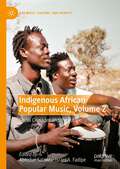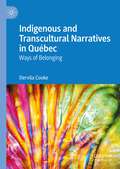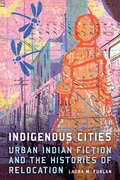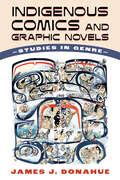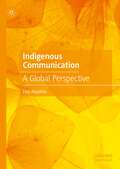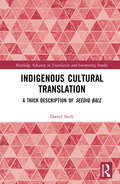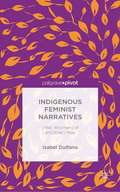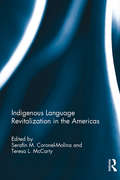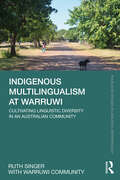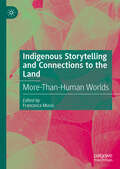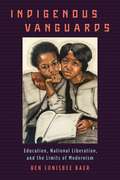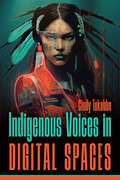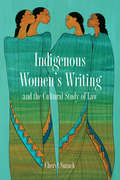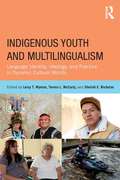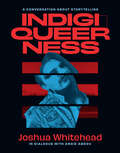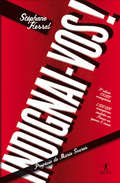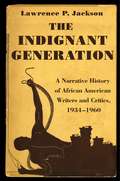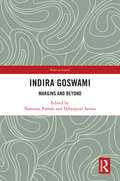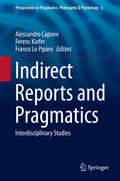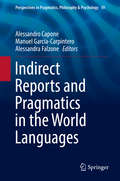- Table View
- List View
Indigenous African Popular Music, Volume 2: Social Crusades and the Future (Pop Music, Culture and Identity)
by Abiodun Salawu Israel A. FadipeThis volume examines how African indigenous popular music is deployed in democracy, politics and for social crusades by African artists. Exploring the role of indigenous African popular music in environmental health communication and gender empowerment, it subsequently focuses on how the music portrays the African future, its use by African youths, and how it is affected by advanced broadcast technologies and the digital media. Indigenous African popular music has long been under-appreciated in communication scholarship. However, understanding the nature and philosophies of indigenous African popular music reveals an untapped diversity which can only be unraveled by the knowledge of myriad cultural backgrounds from which its genres originate. With a particular focus on scholarship from Nigeria, Zimbabwe and South Africa, this volume explores how, during the colonial period and post-independence dispensation, indigenous African music genres and their artists were mainstreamed in order to tackle emerging issues, to sensitise Africans about the affairs of their respective nations and to warn African leaders who have failed and are failing African citizenry about the plight of the people. At the same time, indigenous African popular music genres have served as a beacon to the teeming African youths to express their dreams, frustrations about their environments and to represent themselves. This volume explores how, through the advent of new media technologies, indigenous African popular musicians have been working relentlessly for indigenous production, becoming champions of good governance, marginalised population, and repositories of indigenous cultural traditions and cosmologies.
Indigenous and Transcultural Narratives in Québec: Ways of Belonging
by Dervila CookeThis book focuses on modes of cultural belonging in Québec. It looks at recent literary memoir, autobiographical fiction, and documentary testimony. Through four in-depth case studies of cultural creators, one Indigenous and three non-Indigenous, Dervila Cooke discusses multicultural and ethnically diverse society in Québec, examining current tensions, challenges, and opportunities. Works studied range from Abla Farhoud’s first novel in 1998 to Anita Aloisio’s 2022 documentary film Calliari, QC. Topics include the desire for freedom to self-ascribe and enact cultural identity, self-reinvention through fiction, expressions of Indigeneity in Naomi Fontaine, the term “Québécois”, especially after Bill 21, and the thorny question of integration of immigrants, discussed in relation to Akos Verboczy’s Rhapsodie québécoise. As with the companion volume on France, societal factors are discussed, here relating to the cultural renaissance of Indigenous writing, Farhoud’s Libano-Québécois context, and language laws in Québec, including the foundational Bill 101 and the more recent Bill 96.
Indigenous Cities: Urban Indian Fiction and the Histories of Relocation
by Laura M. FurlanIn Indigenous Cities Laura M. Furlan demonstrates that stories of the urban experience are essential to an understanding of modern Indigeneity. She situates Native identity among theories of diaspora, cosmopolitanism, and transnationalism by examining urban narratives—such as those written by Sherman Alexie, Janet Campbell Hale, Louise Erdrich, and Susan Power—along with the work of filmmakers and artists. In these stories Native peoples navigate new surroundings, find and reformulate community, and maintain and redefine Indian identity in the postrelocation era. These narratives illuminate the changing relationship between urban Indigenous peoples and their tribal nations and territories and the ways in which new cosmopolitan bonds both reshape and are interpreted by tribal identities. Though the majority of American Indigenous populations do not reside on reservations, these spaces regularly define discussions and literature about Native citizenship and identity. Meanwhile, conversations about the shift to urban settings often focus on elements of dispossession, subjectivity, and assimilation. Furlan takes a critical look at Indigenous fiction from the last three decades to present a new way of looking at urban experiences, one that explains mobility and relocation as a form of resistance. In these stories Indian bodies are not bound by state-imposed borders or confined to Indian Country as it is traditionally conceived. Furlan demonstrates that cities have always been Indian land and Indigenous peoples have always been cosmopolitan and urban.
Indigenous Comics and Graphic Novels: Studies in Genre
by James J. DonahueIn recent years, studios like Marvel and DC have seen enormous success transforming comics into major motion pictures. At the same time, bookstores such as Barnes & Noble in the US and Indigo in Canada have made more room for comic books and graphic novels on their shelves. Yet despite the sustained popular appeal and the heightened availability of these media, Indigenous artists continue to find their work given little attention by mainstream publishers, booksellers, production houses, and academics. Nevertheless, Indigenous artists are increasingly turning to graphic narratives, with publishers like Native Realities LLC and Highwater Press carving out ever more space for Indigenous creators. In Indigenous Comics and Graphic Novels: Studies in Genre, James J. Donahue aims to interrogate and unravel the disparities of representation in the fields of comics studies and comics publishing. Donahue documents and analyzes the works of several Indigenous artists, including Theo Tso, Todd Houseman, and Arigon Starr. Through topically arranged chapters, the author explores a wide array of content produced by Indigenous creators, from superhero and science fiction comics to graphic novels and experimental narratives. While noting the importance of examining how Indigenous works are analyzed, Donahue emphasizes that the creation of artistic and critical spaces for Indigenous comics and graphic novels should be an essential concern for the comics studies field.
Indigenous Communication: A Global Perspective
by Eno AkpabioThis book explores global forms of indigenous communication and their connections with new and digital media. With fresh and original insights, the book transcends the confines of regional analysis to investigate similarities, parallels, and differences present in indigenous communication practices around the world.Through a systematic classification of these diverse methods, including music, myths, iconography, visual, institutional, and axiomatic communication, the author draws comparisons between geographically and historically disparate contexts. Indigenous Communication provides a rigorous conceptual clarification of indigenous forms of communication, both showcasing their various manifestations, and illuminating their relevance and transformative potential in the digital age.
Indigenous Cosmolectics: Kab'awil and the Making of Maya and Zapotec Literatures (Critical Indigeneities)
by Gloria Elizabeth ChacónLatin America's Indigenous writers have long labored under the limits of colonialism, but in the late twentieth and twenty-first centuries, they have constructed a literary corpus that moves them beyond those parameters. Gloria E. Chacon considers the growing number of contemporary Indigenous writers who turn to Maya and Zapotec languages alongside Spanish translations of their work to challenge the tyranny of monolingualism and cultural homogeneity. Chacon argues that these Maya and Zapotec authors reconstruct an Indigenous literary tradition rooted in an Indigenous cosmolectics, a philosophy originally grounded in pre-Columbian sacred conceptions of the cosmos, time, and place, and now expressed in creative writings. More specifically, she attends to Maya and Zapotec literary and cultural forms by theorizing kab'awil as an Indigenous philosophy. Tackling the political and literary implications of this work, Chacon argues that Indigenous writers' use of familiar genres alongside Indigenous language, use of oral traditions, and new representations of selfhood and nation all create space for expressions of cultural and political autonomy. Chacon recognizes that Indigenous writers draw from universal literary strategies but nevertheless argues that this literature is a vital center for reflecting on Indigenous ways of knowing and is a key artistic expression of decolonization.
Indigenous Cultural Translation: A Thick Description of Seediq Bale (Routledge Advances in Translation and Interpreting Studies)
by Darryl SterkIndigenous Cultural Translation is about the process that made it possible to film the 2011 Taiwanese blockbuster Seediq Bale in Seediq, an endangered indigenous language. Seediq Bale celebrates the headhunters who rebelled against or collaborated with the Japanese colonizers at or around a hill station called Musha starting on October 27, 1930, while this book celebrates the grandchildren of headhunters, rebels, and collaborators who translated the Mandarin-language screenplay into Seediq in central Taiwan nearly eighty years later. As a "thick description" of Seediq Bale, this book describes the translation process in detail, showing how the screenwriter included Mandarin translations of Seediq texts recorded during the Japanese era in his screenplay, and then how the Seediq translators backtranslated these texts into Seediq, changing them significantly. It argues that the translators made significant changes to these texts according to the consensus about traditional Seediq culture they have been building in modern Taiwan, and that this same consensus informs the interpretation of the Musha Incident and of Seediq culture that they articulated in their Mandarin-Seediq translation of the screenplay as a whole. The argument more generally is that in building cultural consensus, indigenous peoples like the Seediq are "translating" their traditions into alternative modernities in settler states around the world.
Indigenous Feminist Narratives I/We: Wo(men) of an(Other) Way
by Isabel DulfanoThis book analyzes the literary representation of Indigenous women in Latin American letters from colonization to the twentieth century, arguing that contemporary theorization of Indigenous feminism deconstructs denigratory imagery and offers a (re)signification, (re)semantization and reinvigoration of what it means to be an Indigenous woman.
Indigenous Knowledge and Material Histories: The Example of Rubber (Elements in Environmental Humanities)
by Jens SoentgenThis Element deals with stories told about substances and ways to analyse them through an Environmental Humanitie's perspective. It then takes up rubber as an example and its many stories. It is shown that the common notions of rubber history, which assume that rubber only became a useful material through a miraculous operation called vulcanization, that is attributed to the US-American Charles Goodyear, are false. In contrast, it is shown that rubber and many important rubber products are inventions of Indigenous peoples of South America, made durable by a process that can be called organic vulcanization. It is with that invention, that the story of rubber starts. Without it, rubber would not exist, neither in the Americas nor elsewhere. Finally, it is shown that Indigenous rubber products also offer some ecological advantages over industrially manufactured ones.
Indigenous Language Revitalization in the Americas
by Serafín M. Coronel-Molina Teresa L. McCartyFocusing on the Americas – home to 40 to 50 million Indigenous people – this book explores the history and current state of Indigenous language revitalization across this vast region. Complementary chapters on the USA and Canada, and Latin America and the Caribbean, offer a panoramic view while tracing nuanced trajectories of "top down" (official) and "bottom up" (grass roots) language planning and policy initiatives. Authored by leading Indigenous and non-Indigenous scholars, the book is organized around seven overarching themes: Policy and Politics; Processes of Language Shift and Revitalization; The Home-School-Community Interface; Local and Global Perspectives; Linguistic Human Rights; Revitalization Programs and Impacts; New Domains for Indigenous Languages Providing a comprehensive, hemisphere-wide scholarly and practical source, this singular collection simultaneously fills a gap in the language revitalization literature and contributes to Indigenous language revitalization efforts.
Indigenous Multilingualism at Warruwi: Cultivating Linguistic Diversity in an Australian Community (Routledge Studies in Linguistic Anthropology)
by Ruth SingerThis book is an exploration of the role of language at Warruwi Community, a remote Indigenous settlement in northern Australia. It explores how language use and people’s ideas about language are embedded in contemporary Indigenous life there. Using an ethnographic approach, the book examines what language at Warruwi means in the context of the history of the community, ongoing social and political changes and the continuing importance of ancestral traditions. Children growing up at Warruwi still learn to speak many small Indigenous languages. This is remarkable not just in the Australian context, where many Indigenous languages are no longer spoken, but around the world as this kind of multilingualism in small languages persists only in a few remaining pockets. The way that people use many languages in their daily life at Warruwi reveals how high levels of linguistic diversity can be maintained in a small community. This detailed study of the creation of linguistic diversity is relevant to sociolinguistics, linguistic typology, historical linguistics and evolutionary linguistics. More generally, this book is for linguists, anthropologists and anyone with an interest in contemporary Australian Indigenous lives.
Indigenous Plots in Twenty-First Century Latin American Cinema
by Maria Chiara D'ArgenioIn this engaging book, Maria Chiara D’Argenio delineates a turn in recent Latin American filmmaking towards inter/cultural feature films made by non-Indigenous directors. Aimed at a global audience, but played by Indigenous actors, these films tell Indigenous stories in Indigenous languages. Over the last two decades, a growing number of Latin American films have screened the Indigenous experience by combining the local and the global in a way that has proved appealing at international film festivals. Locating the films in composite webs of past and present traditions and forms, Indigenous Plots in Twenty-First Century Latin American Cinema examines the critical reflection offered by recent inter/cultural films and the socio-cultural impact, if any, they might have had. Through the analysis of a selection of films produced between 2006 and 2019, the book gauges the extent to which non-Indigenous directors who set out to engage critically with colonial legacies and imaginaries, as well as with contemporary Indigenous marginalization, succeed in addressing these concerns by ‘unthinking’ and ‘undoing’ Western centrism and coloniality. Drawing on a wide range of disciplines and considering the entire cinematic process – from pre-production to the films’ production, circulation and critical reception – Indigenous Plots in Twenty-First Century Latin American Cinema makes the case for a holistic cultural criticism to explain the cultural and political work cinema does in specific historical contexts.
Indigenous Storytelling and Connections to the Land: More-Than-Human Worlds
by Francesca MussiThis book builds on the perspective that, for Indigenous peoples, relations to the land are familial, intimate, intergenerational, spiritual, instructive, and life nourishing, and it is these relations that Western societies sought to destroy as part of their colonial projects of territorial conquest and exploitation of resources. Positioning storytelling as a research methodology and a model of decolonial practice, this edited collection seeks to explore the following key questions: how does Indigenous storytelling contribute to understanding Indigenous identity and the crucial role of the land in Indigenous ways of life? How can Indigenous storytelling subvert colonial narratives of the land? How can Indigenous storytelling contribute to addressing colonial exploitations of the land and its resources? Can Indigenous storytelling become a rich mode for the investigation of current climate crises? And, finally, how does storytelling assist Indigenous peoples in restoring their intimate relations to the land and its natural gifts? Through critical analysis of a unique range of Indigenous storytelling practices, including fiction, performative art, new media platforms, archaeological findings and personal live-experienced stories, this collection aims to examine the interplay between colonialism and current environmental challenges, and to expose the impacts – past, present, and future – of Western worldviews on Indigenous connections to the land, whilst simultaneously bringing to the fore Indigenous ethos of care and land custodianship.
Indigenous Vanguards: Education, National Liberation, and the Limits of Modernism (Modernist Latitudes)
by Ben Conisbee BaerAnticolonial struggles of the interwar epoch were haunted by the question of how to construct an educational practice for all future citizens of postcolonial states. In what ways, vanguard intellectuals asked, would citizens from diverse subaltern situations be equally enabled to participate in a nonimperial society and world? In circumstances of cultural and social crisis imposed by colonialism, these vanguards sought to refashion modern structures and technologies of public education by actively relating them to residual indigenous collective forms.In Indigenous Vanguards, Ben Conisbee Baer provides a theoretical and historical account of literary engagements with structures and representations of public teaching and learning by cultural vanguards in the colonial world from the 1920s to the 1940s. He shows how modernizing educative projects existed in complex tension with impulses to indigenize national liberation movements, and how this tension manifests as a central aspect of modernist literary practice. Offering new readings of figures such as Alain Locke, Léopold Senghor, Aimé Césaire, D. H. Lawrence, Rabindranath Tagore, Mahatma Gandhi, and Tarashankar Bandyopadhyay, Baer discloses the limits and openings of modernist representations as they attempt to reach below the fissures of class that produce them. Establishing unexpected connections between languages and regions, Indigenous Vanguards is the first study of modernism and colonialism that encompasses the decisive way public education transformed modernist aesthetics and vanguard politics.
Indigenous Voices in Digital Spaces
by Cindy TekobbeIndigenous Voices in Digital Spaces applies Indigenous frameworks and epistemologies to online cultural movements through four case studies, including hashtags, memes, cryptocurrency, and digital artistry, and develops decolonizing practices for digital rhetoric, online identity work, and digital literacy practices. Tekobbe’s methods for analyzing and understanding Indigenous knowledges online center Indigenous storytelling and “thick” (broad, deep, and complex) Indigenous meaning-making. Employing this thickness to interpret Indigenous knowledge ways resists the settler-colonial logics that tend to flatten complex Indigenous concepts into one-note representations of racial stereotypes. Native Americans’ use of social media and digital platforms to support social movements uniquely constructs Indigenous identities as living, producing, and culture-making people, which confronts the commonplace, one-dimensional narrative that Indigenous North Americans either live in isolation or are people of history resigned to the long-forgotten past. Tekobbe’s methods are applicable to additional online research to break through Western paradigms of oppositional critique, the colonial power matrix embedded in hierarchical and taxonomical classification systems, and participant objectification. Indigenous Voices in Digital Spaces offers new methodological and epistemological opportunities to explore digital communities and technologies, problematizing conventional Western critique. This book is useful to instructors in Indigenous studies, internet studies, digital literacies, cultural studies, and communications, as well as Indigenous and internet studies researchers.
Indigenous Women's Writing and the Cultural Study of Law
by Cheryl SuzackIn Indigenous Women’s Writing and the Cultural Study of Law, Cheryl Suzack explores Indigenous women’s writing in the post-civil rights period through close-reading analysis of major texts by Leslie Marmon Silko, Beatrice Culleton Mosionier, Louise Erdrich, and Winona LaDuke. Working within a transnational framework that compares multiple tribal national contexts and U.S.-Canadian settler colonialism, Suzack sheds light on how these Indigenous writers use storytelling to engage in social justice activism by contesting discriminatory tribal membership codes, critiquing the dispossession of Indigenous women from their children, challenging dehumanizing blood quantum codes, and protesting colonial forms of land dispossession. Each chapter in this volume aligns a court case with a literary text to show how literature contributes to self-determination struggles. Situated at the intersections of critical race, Indigenous feminist, and social justice theories, Indigenous Women’s Writing and the Cultural Study of Law crafts an Indigenous-feminist literary model in order to demonstrate how Indigenous women respond to the narrow vision of law by recuperating other relationships–to themselves, the land, the community, and the settler-nation.
Indigenous Youth and Multilingualism: Language Identity, Ideology, and Practice in Dynamic Cultural Worlds
by Teresa L. McCarty Leisy T. Wyman Sheilah E. NicholasBridging the fields of youth studies and language planning and policy, this book takes a close, nuanced look at Indigenous youth bi/multilingualism across diverse cultural and linguistic settings, drawing out comparisons, contrasts, and important implications for language planning and policy and for projects designed to curtail language loss. Indigenous and non-Indigenous scholars with longstanding ties to language planning efforts in diverse Indigenous communities examine language policy and planning as de facto and de jure – as covert and overt, bottom-up and top-down. This approach illuminates crosscutting themes of language identity and ideology, cultural conflict, and linguistic human rights as youth negotiate these issues within rapidly changing sociolinguistic contexts. A distinctive feature of the book is its chapters and commentaries by Indigenous scholars writing about their own communities. This landmark volume stands alone in offering a look at diverse Indigenous youth in multiple endangered language communities, new theoretical, empirical, and methodological insights, and lessons for intergenerational language planning in dynamic sociocultural contexts.
Indigiqueerness: A Conversation about Storytelling
by Joshua WhiteheadEvolving from a conversation between Joshua Whitehead and Angie Abdou, Indigiqueerness is part dialogue, part collage, and part memoir. Beginning with memories of his childhood poetry and prose and travelling through the library of his life, Whitehead contemplates the role of theory, Indigenous language, queerness, and fantastical worlds in all his artistic pursuits. This volume is imbued with Whitehead’s energy and celebrates Indigenous writers and creators who defy expectations and transcend genres.
Indignai-vos
by Stéphane Hessel1.500.000 exemplares vendidos em França em apenas 5 meses. «Um pequeno grande livro, com ideias inovadoras e críticas certeiras»Mário Soares «A minha longa vida deu me uma série de motivos para me indignar.» Quem o escreve é Stéphane Hessel, herói da Resistência francesa, sobrevivente dos campos de concentração nazis e um dos redactores da Declaração Universal dos Direitos Humanos. É com a autoridade moral de um resistente inconformado e de um lutador visionário que Stéphane Hessel nos alerta, neste breve manifesto, para o facto de existirem hoje tantos e tão sérios motivos para a indignação como no tempo em que o nacional-socialismo ameaçava o mundo livre. Se procurarmos, certamente encontraremos razões para a indignação: o fosso crescente entre muito pobres e muito ricos, o estado do planeta, o desrespeito pelos imigrantes e pelos direitos humanos, a ditadura intolerável dos mercados financeiros, a injustiça social, entre tantos outros. Aceitemos o desafio de Stéphane Hessel, procurando neste livro e no mundo que nos rodeia os motivos para a insurreição pacífica, pois «cabe-nos a todos em conjunto zelar para que a nossa sociedade se mantenha uma sociedade da qual nos orgulhemos».
The Indignant Generation: A Narrative History of African American Writers and Critics, 1934-1960
by Lawrence P. JacksonThe Indignant Generation is the first narrative history of the neglected but essential period of African American literature between the Harlem Renaissance and the civil rights era. The years between these two indispensable epochs saw the communal rise of Richard Wright, Gwendolyn Brooks, Ralph Ellison, Lorraine Hansberry, James Baldwin, and many other influential black writers. While these individuals have been duly celebrated, little attention has been paid to the political and artistic milieu in which they produced their greatest works. With this commanding study, Lawrence Jackson recalls the lost history of a crucial era. Looking at the tumultuous decades surrounding World War II, Jackson restores the "indignant" quality to a generation of African American writers shaped by Jim Crow segregation, the Great Depression, the growth of American communism, and an international wave of decolonization. He also reveals how artistic collectives in New York, Chicago, and Washington fostered a sense of destiny and belonging among diverse and disenchanted peoples. As Jackson shows through contemporary documents, the years that brought us Their Eyes Were Watching God, Native Son, and Invisible Man also saw the rise of African American literary criticism--by both black and white critics. Fully exploring the cadre of key African American writers who triumphed in spite of segregation, The Indignant Generation paints a vivid portrait of American intellectual and artistic life in the mid-twentieth century.
Indira Goswami: Margins and Beyond (Writer in Context)
by Namrata Pathak and Dibyajyoti SarmaThis book engages with the life and works of Indira Goswami, the first Assamese woman writer to win the highest national literary award, the Jnanpith, in 2001. From sociological treatises to a springboard of a socio-political milieu, Goswami’s texts are intersections of the local and the global, the popular and the canonical. The writer’s penchant for transcending boundaries gives a new contour and shape to the social and cultural domains in her texts. That every character is a representative of the society, that the context comes alive in every evocation of class struggle, power play, caste discrimination and gendered narratives add an interesting semantic load to her texts. While tracing the trajectories discussed above, this book foregrounds Goswami’s act of going beyond the margins of varied kinds, both abstract and concrete, in search of egalitarian and democratic spaces of life. The book looks at Indira Goswami’s works with a special emphasis on the author situated within the Assamese literary canon. It not only discusses the themes and issues within her writing, but also focuses on the distinct language and style she uses. The volume includes non-fictional prose, excerpts from her short stories and novels, viewpoints of critics, letters and entries from diaries, as well as interviews with Goswami about her writing and personal life. It engages with her works in the context of her multifaceted, almost mythical life, especially her avowed ‘activism’ against animal sacrifice and militancy in her latter career. Part of the Writer in Context series, this book will be useful for scholars and researchers of Indian literature, Assamese literature, English literature, postcolonial studies, cultural studies, global south studies, gender studies, and translation studies.
Indira Goswami: Margins and Beyond (Writer in Context)
by Namrata Pathak and Dibyajyoti SarmaThis book engages with the life and works of Indira Goswami, the first Assamese woman writer to win the highest national literary award, the Jnanpith Award, in 2001. From sociological treatises to a springboard of a socio-political milieu, Goswami’s texts are intersections of the local and the global, the popular and the canonical. The writer’s penchant for transcending boundaries gives a new contour and shape to the social and cultural domains in her texts. That every character is a representative of the society, that the context comes alive in every evocation of class struggle, power play, caste discrimination and gendered narratives add an interesting semantic load to her texts. While tracing the trajectories discussed above, this book foregrounds Goswami’s act of going beyond the margins of varied kinds, both abstract and concrete, in search of egalitarian and democratic spaces of life.The book looks at Indira Goswami’s works with a special emphasis on the author situated within the Assamese literary canon. It not only discusses the themes and issues within her writing, but also focuses on the distinct language and style she uses. The volume includes non-fictional prose, excerpts from her short stories and novels, viewpoints of critics, letters and entries from diaries, as well as interviews with Goswami about her writing and personal life. It engages with her works in the context of her multifaceted, almost mythical life, especially her avowed ‘activism’ against animal sacrifice and militancy in her latter career.Part of the Writer in Context series, this book will be useful for scholars and researchers of Indian literature, Assamese literature, English literature, postcolonial studies, cultural studies, global south studies, gender studies and translation studies.
Indirect Reports and Pragmatics
by Alessandro Capone Ferenc Kiefer Franco Lo PiparoThis volume offers the reader a singular overview of current thinking on indirect reports. The contributors are eminent researchers from the fields of philosophy of language, theoretical linguistics and communication theory, who answer questions on this important issue. This exciting area of controversy has until now mostly been treated from the viewpoint of philosophy. This volume adds the views from semantics, conversation analysis and sociolinguistics. Authors address matters such as the issue of semantic minimalism vs. radical contextualism, the attribution of responsibility for the modes of presentation associated with Noun Phrases and how to distinguish the indirect reporter's responsibility from the original speaker's responsibility. They also explore the connection between indirect reporting and direct quoting. Clearly indirect reporting has some bearing on the semantics/pragmatics debate, however, there is much controversy on "what is said", whether this is a minimal semantic logical form (enriched by saturating pronominals) or a much richer and fully contextualized logical form. This issue will be discussed from several angles. Many of the authors are contextualists and the discussion brings out the need to take context into account when one deals with indirect reports, both the context of the original utterance and the context of the report. It is interesting to see how rich cues and clues can radically transform the reported message, assigning illocutionary force and how they can be mobilized to distinguish several voices in the utterance. Decoupling the voice of the reporting speaker from that of the reported speaker on the basis of rich contextual clues is an important issue that pragmatic theory has to tackle. Articles on the issue of slurs will bring new light to the issue of decoupling responsibility in indirect reporting, while others are theoretically oriented and deal with deep problems in philosophy and epistemology.
Indirect Reports and Pragmatics in the World Languages (Perspectives in Pragmatics, Philosophy & Psychology #19)
by Alessandro Capone Manuel García-Carpintero Alessandra FalzoneThis volume addresses the intriguing issue of indirect reports from an interdisciplinary perspective. The contributors include philosophers, theoretical linguists, socio-pragmaticians, and cognitive scientists. The book is divided into four sections following the provenance of the authors. Combining the voices from leading and emerging authors in the field, it offers a detailed picture of indirect reports in the world’s languages and their significance for theoretical linguistics. Building on the previous book on indirect reports in this series, this volume adds an empirical and cross-linguistic approach that covers an impressive range of languages, such as Cantonese, Japanese, Hebrew, Persian, Dutch, Spanish, Catalan, Armenian, Italian, English, Hungarian, German, Rumanian, and Basque.
Indirect Speech Acts (Key Topics in Semantics and Pragmatics)
by Nicolas RuytenbeekTo achieve successful communication, it is crucial to say clearly what we mean, but, at the same time, we need to pay attention to the form of our utterances, to avoid misunderstandings and the risk of offending our interlocutors. To avoid these pitfalls, we use a special category of utterances called 'indirect speech acts' (ISAs) that enable an optimal balance between clarity and politeness. But how do interpreters identify the meaning of these ISAs? And how does the social context influence the use of ISAs? This book attempts to answer these questions. It deals with the main theoretical and empirical questions surrounding the meaning and usage of ISAs, drawing on the latest research and neuroimaging data. Adopting a truly interdisciplinary perspective, it will appeal to students and scholars from diverse backgrounds, and anyone interested in exploring this phenomenon, which is so pervasive in our daily lives.
